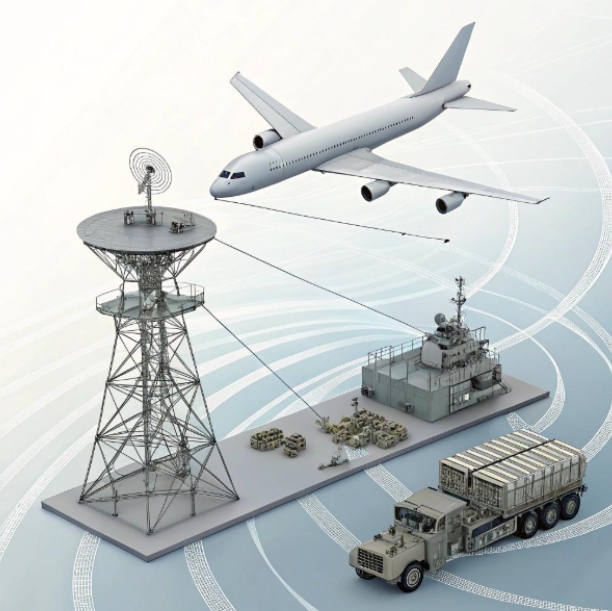Tech
An Overview of Industrial Networking Solutions
Industrial networking solutions are becoming an integral part of any enterprise throughout the world. This is because it’s crucial for businesses to be able to seamlessly communicate and collaborate with each other.
Published
3 years agoon
By
Marks StrandIndustrial networking solutions are intended for distributed real-time control. They are widely used in the industry to link equipment and tools, for example. They are used in process and building automation, in addition to manufacturing applications.
Advantages
- Longevity: Because it is a communication standard built exclusively for industrial applications, its cables and components are extremely sturdy, robust, and capable of withstanding harsh physical conditions.
- Reliability: Its networks have short signal routes and enhanced interference prevention, which improves network stability and reliability.
- Interoperability: It has been around for a long time and is standardized, making it simple to integrate equipment from diverse manufacturers into a single system.

Disadvantages
- Expensive network equipment and components:Some of the equipment that is traditionally used to build industrial networks is expensive, making the setup of such solutions a costly investment.
- Low data transfer rates: Traditional network solutions commonly used in industries don’t have the high speeds found in modern Ethernet solutions. Some of the solutions have speeds as low as a few hundreds of kilobytes per second.
- High level of complexity: Traditional solutions are, to a large extent, reliant on sophisticated proprietary manufacturer equipment. The deployment and maintenance of such solutions needs rare expertise, further contributing to the cost of the solutions.
Carrier Ethernet Network
This is an application of Ethernet technology that enables network providers to leverage Ethernet technology and deliver Ethernet services to their clients. It enables local area networks of corporate, academic, private, and governmental organizations to connect to the Internet and communicate with one another.
Through the use of carrier ethernet network technology, service providers may establish service-level agreements that provide improved data speeds and service quality for phone and mobile services. Service providers can select from a wide range of wide area technologies to offer the level of service since specified services only specify the service and not the underlying technology.
Transport technologies that fulfill the required performance standards, such as Synchronous Optical Network, Synchronous Digital Hierarchy, and others, are used for data transfer.
Additionally, service providers offer operations, administration, and maintenance services using Carrier Ethernet. These management tools are used by carriers to keep an eye on network performance and provide consumers with dependable network access. The most widely used industrial networking method is carrier ethernet, an implementation of the Ethernet protocol in industrial environments with an emphasis on real-time control.
Network Timing Technology
Any network needs time synchronization, but it’s frequently implemented as an afterthought. Still, it can make the difference between solving a dispute successfully in a matter of minutes and being unable to figure out why the server is really on fire. This is happening even while time synchronization precision in the sub-millisecond region is being pushed for by commercial and industrial organizations.
Because NTP networks are software-based and dependent on the local operating system, they have higher latency and lower accuracy. For the majority of businesses, it offers a precise-enough time resolution to resolve disputes quickly. However, some establishments, like the laboratories, demand a far higher degree of synchronization.
Why Bother With Network Timing
Some network engineers continue to believe that they can get away with just synchronizing their servers to an open internet clock. Timestamping and client synchronization are essential for your network. Internet clocks are bad for corporate networks for one reason only, security, despite being okay for consumer devices like smartphones.
Conclusion
It’s crucial to use well-known technologies like Wi-Fi, Bluetooth, and Ethernet when adopting wireless technology in industrial networking situations. The hardware and protocols of the former are altered to fit more complex network topologies and the use cases of industrial networks, which is the only distinction between industrial wireless solutions and commercial or home-use wireless solutions.
You may like
Business Solutions
Turning Up the Heat on Aging: Understanding Radio Frequency Skin Tightening
Discover how Radio Frequency Skin Tightening is revolutionizing non-invasive anti-aging treatments. This guide breaks down how RF technology works, its benefits for reducing wrinkles and firming skin, and why it’s becoming a go-to solution for those looking to rejuvenate their appearance without surgery.
Published
4 days agoon
April 24, 2025By
Adva
In the ongoing quest for youthful and rejuvenated skin, a variety of non-surgical medical aesthetic devices and technologies have emerged, each promising to turn back the clock. Among these, Radio Frequency (RF) skin tightening has gained significant popularity for its ability to address skin laxity, wrinkles, and overall skin texture without the need for invasive procedures or lengthy downtime.
How Radio Frequency Works its Magic:
Radio frequency skin tightening utilizes electromagnetic waves to deliver controlled heat deep into the skin’s layers, specifically the dermis. This targeted thermal energy triggers a cascade of beneficial responses within the skin:
Collagen Contraction: The heat causes existing collagen fibers to contract and tighten, providing an immediate firming effect. Think of it like shrinking a loose sweater.
Collagen Stimulation: More importantly, the controlled thermal injury stimulates fibroblasts, the cells responsible for producing collagen and elastin. This prompts the generation of new, healthy collagen fibers over time, leading to long-term improvement in skin elasticity and firmness.
Improved Circulation: The heating effect also enhances blood circulation in the treated area, bringing more oxygen and nutrients to the skin cells, further contributing to a healthier and more vibrant complexion.
The Benefits of RF Skin Tightening:
The appeal of radio frequency technology lies in its ability to deliver noticeable results with minimal disruption to daily life. Key benefits include:
Non-Invasive: Unlike surgical facelifts, RF treatments require no incisions, stitches, or anesthesia, making them a comfortable and convenient option.
Skin Tightening and Firming: The primary benefit is the visible tightening of loose or sagging skin on the face, neck, and body. This can improve the appearance of jowls, brow lines, and loose skin on the abdomen and arms.
Wrinkle and Fine Line Reduction: By stimulating collagen production, RF can help to smooth out fine lines and wrinkles, resulting in a more youthful appearance.
Improved Skin Texture and Tone: The treatment can enhance overall skin texture, making it smoother and more even-toned. It can also help to minimize the appearance of sun damage and enlarged pores.
Gradual and Natural-Looking Results: The improvements from RF treatments are typically gradual, appearing over several weeks and months as new collagen is produced, leading to a natural-looking rejuvenation.
Minimal Downtime: Most individuals experience little to no downtime after an RF session and can typically return to their normal activities immediately.
Versatility: RF technology can be used to treat various areas of the face and body, including the forehead, cheeks, jawline, neck, décolletage, abdomen, arms, and thighs.
Suitable for Most Skin Types: Generally, RF treatments are considered safe for a wide range of skin types and tones.

What to Expect During an RF Treatment:
A typical RF skin tightening session involves the following:
Preparation: The skin in the treatment area is cleansed, and a conductive gel is applied to help the RF device glide smoothly and ensure efficient energy delivery.
Treatment: A handheld RF device is moved over the targeted areas. You may feel a warming sensation, which is generally well-tolerated. Some devices incorporate cooling mechanisms to enhance comfort.
Post-Treatment: After the session, the gel is removed, and a soothing lotion or sunscreen may be applied.
The duration of a treatment session can vary depending on the size of the area being treated, typically ranging from 30 to 60 minutes. A series of treatments is usually recommended to achieve optimal and long-lasting results, with sessions spaced a few weeks apart. Maintenance treatments may also be advised to sustain the benefits over time.
Potential Side Effects and Considerations:
While RF skin tightening is generally considered safe, some mild and temporary side effects may occur, including:
Redness: The treated area may appear flushed or red immediately after the procedure, which usually subsides within a few hours to a day.
Swelling: Mild swelling or puffiness can occur but typically resolves within a day or two.
Warmth or Tingling: A lingering sensation of warmth or tingling in the treated area is common and usually temporary.
Dryness: Some individuals may experience temporary skin dryness.
More serious side effects are rare when the procedure is performed by a qualified and experienced professional using FDA-approved devices. However, potential risks can include burns, blistering, or temporary changes in skin pigmentation, particularly if the treatment is not administered correctly.
Choosing the Right Provider:
To ensure a safe and effective RF skin tightening experience, it is crucial to choose a reputable clinic and a qualified practitioner with specific training and experience in this technology. During your consultation, discuss your skin concerns, medical history, and expectations to determine if RF skin tightening is the right option for you.
Radio frequency skin tightening technology offers a promising non-surgical solution for those seeking to combat the signs of aging and achieve firmer, smoother, and more youthful-looking skin. By harnessing the power of controlled thermal energy to stimulate collagen production and tighten existing fibers, RF treatments provide a gradual and natural-looking rejuvenation with minimal downtime. While generally safe, it’s essential to understand the potential side effects and choose a qualified provider to maximize benefits and minimize risks on your journey to radiant skin.
Business Solutions
Mil-Aero RF Applications Power Up With 5G DAS
The integration of 5G DAS is propelling Mil-Aero RF Applications into a new era of efficiency and reliability. By delivering unmatched connectivity and advanced communication capabilities, 5G DAS enhances the precision and performance of military and aerospace RF technologies. This innovation is streamlining operations, improving data transmission, and paving the way for smarter, faster solutions in critical industries. Explore how 5G DAS is revolutionizing the future of defense and aerospace communication systems.
Published
6 days agoon
April 22, 2025By
Adva
The 5G DAS Boom in Aerospace and Defense
As 5G standards continue to evolve and new spectrum (like mmWave and sub-THz) becomes accessible, the potential for 5G DAS in Mil-Aero RF applications is expanding. Future systems will likely incorporate beamforming, AI-defined networking, and autonomous RF management.
The distributed antenna system (DAS) model, once reserved for stadiums and city centers, has now found a new frontier—military and aerospace environments. With the exponential demand for bandwidth, low latency, and secure communication, 5G DAS is being adopted by armed forces and aerospace manufacturers to meet unprecedented performance requirements.
Defense facilities, aircraft hangars, and command centers are increasingly turning to DAS to extend high-speed, reliable 5G coverage indoors and across large areas. Traditional signal architectures simply can’t keep up with the data throughput and latency expectations of modern RF-driven systems.
Integrating 5G DAS allows defense leaders to future-proof their communications infrastructure—meeting today’s demands while preparing for tomorrow’s threats.
Understanding Mil-Aero RF Requirements
In the Mil-Aero space, RF isn’t just about connectivity—it’s about survivability, accuracy, and split-second decisions. Unlike commercial settings, where a dropped signal is annoying, failure in a military context can be catastrophic.
RF systems in this space must endure electromagnetic interference, extreme temperatures, high G-forces, and prolonged operations under hostile conditions. Whether it’s radar systems on a fighter jet or data links on an unmanned aerial vehicle, the RF infrastructure must be robust, shielded, and deeply reliable.
Precision timing, spectral purity, and resilience against jamming or spoofing are not optional—they are baseline standards. And 5G DAS brings the flexibility to meet those standards while enabling dynamic scaling and multi-mission adaptability.
The Shift from Legacy Systems to 5G DAS
Legacy radio networks have long served the defense community, but their limitations are now glaring. Fixed infrastructure can’t adapt to rapid deployment. Narrowband systems can’t support AI-powered drones or satellite uplinks. And analog RF paths can’t deliver the latency-sensitive data modern forces rely on.
5G DAS provides an answer. With its scalable, modular design, DAS can be tailored to both temporary forward-operating bases and permanent installations. It enables hybrid architectures that mix fiber, coax, and wireless links while managing them from a unified platform.
The shift isn’t just about replacing equipment—it’s about reimagining the RF ecosystem with agility in mind.

Secure Communications in Classified Environments
One of the major concerns in Mil-Aero deployments is securing the communication channels that carry classified or mission-sensitive information. Encrypted radios and private mobile networks help, but physical infrastructure like DAS must also meet security specifications.
5G DAS systems used in defense zones are typically deployed with end-to-end encryption, tamper detection, and electromagnetic shielding to protect signal integrity. They can be designed to support air-gapped networks and operate on isolated frequency bands, ensuring zero bleed into unauthorized zones.
Additionally, user authentication and device management are tightly controlled via mobile device management (MDM) protocols, ensuring every node connected to the DAS is accounted for and authorized.
Low Latency and High Reliability in Mission-Critical Ops
Time is a luxury in the theater of operations. Whether coordinating UAVs mid-flight or transmitting reconnaissance data from a remote desert location, latency is the enemy. The reduced latency provided by 5G DAS allows for near-instantaneous communication, even in complex mesh environments.
Unlike traditional RF relay systems, DAS can distribute the signal over multiple antennas with centralized intelligence. This means data doesn’t have to travel long distances to a base station before being routed—it can move through a local edge network in microseconds.
Reliability is equally important. With automatic failover, load balancing, and real-time monitoring, DAS systems reduce single points of failure and keep operations running even when components are damaged or degraded.
Distributed Antenna Systems for Airborne and Ground Units
Deploying communication infrastructure in environments that are always moving, like helicopters, naval vessels, or mobile command vehicles, requires a new kind of system design. This is where DAS demonstrates unmatched versatility.
In airborne platforms, DAS nodes can be mounted in vibration-isolated modules, providing consistent coverage throughout the aircraft. For ground vehicles, compact DAS units enable low-profile signal distribution while remaining ruggedized for off-road terrain and shock loads.
Even submarines and stealth aircraft, which require ultra-low observable emissions, are exploring low-power DAS implementations that deliver internal signal distribution without external signal leakage.
Mil-Aero RF applications are gaining agility and stealth thanks to tailored 5G DAS deployment strategies.

RF Innovation for Tactical Edge Computing
The convergence of edge computing and Mil-Aero RF applications is creating opportunities to process intelligence at the source—before it even reaches central command. But to do this effectively, ultra-reliable RF infrastructure is required.
5G DAS allows real-time streaming of high-definition sensor data, battlefield video feeds, and environmental analytics into localized edge processors embedded in field equipment. This means faster decisions, local autonomy, and the ability to maintain operational capabilities even if satellite links are jammed.
The high bandwidth of 5G also enables massive MIMO (Multiple Input, Multiple Output) capabilities, where dozens or hundreds of antennas can be coordinated for simultaneous data streams—perfect for drone swarms or mobile radar arrays.
How 5G DAS Powers AI-Driven Military Systems
Artificial intelligence is transforming Mil-Aero operations, from autonomous navigation to predictive maintenance and object detection in radar. But AI needs data—and lots of it.
This is where 5G DAS becomes a foundational enabler. The high capacity and low latency of DAS allow for AI systems to ingest data from a distributed sensor grid, process it instantly, and act on insights in real time.
Whether it’s a base monitoring airspace for unidentified drones or a tank detecting anomalies in engine performance, AI-driven RF systems require seamless communication infrastructure to function at scale. 5G DAS delivers just that.
Stay ahead of adversaries by linking AI systems with robust 5G DAS networks for real-time Mil-Aero awareness.
Challenges and Considerations for 5G DAS Deployment
Despite its benefits, deploying 5G DAS in defense environments is not without hurdles. Electromagnetic compatibility is a huge challenge, especially when integrating with radar, avionics, and weapons systems.
Another concern is frequency licensing. While many 5G deployments use public bands, military installations often require dedicated spectrum allocations, which must be coordinated with regulatory bodies and allies.
There’s also the physical logistics: installing DAS in ships, bunkers, and remote terrains often involves custom engineering, power management planning, and climate-resilient materials.
And finally, cybersecurity must be baked into every component—from firmware to physical enclosures—because an unsecured DAS system can be a backdoor into critical RF systems.
The Future of 5G DAS in Mil-Aero RF Evolution
The modularity of DAS means future upgrades—like transitioning to 6G—won’t require full system overhauls. It’s a future-proof architecture that aligns with the lifecycle demands of military and aerospace programs.
The next phase may even include satellite-connected DAS systems, enabling persistent, high-speed RF coverage for forces operating in disconnected, interrupted, or limited (DIL) environments.
Future-proof your Mil-Aero operations by investing in scalable 5G DAS infrastructure today.
FAQs: 5G DAS and Mil-Aero RF Integration
- What is 5G DAS and why is it important for Mil-Aero RF applications?
5G DAS (Distributed Antenna System) is a network of spatially separated antennas connected to a central source to enhance wireless coverage. In Mil-Aero RF applications, it ensures secure, reliable, and high-speed communication across complex operational environments. - How does 5G DAS improve communication in military and aerospace operations?
It reduces latency, increases bandwidth, and provides consistent signal coverage across large or shielded environments, supporting real-time decision-making and mission-critical operations. - What are the unique RF requirements in Mil-Aero environments?
Military and aerospace RF systems must withstand extreme conditions, resist interference, support precise synchronization, and deliver secure communications without failure. - Can 5G DAS be used in mobile or airborne military units?
Yes. 5G DAS can be ruggedized and miniaturized for use in vehicles, aircraft, and other mobile platforms while maintaining reliable signal distribution and performance. - What role does 5G DAS play in secure communications?
5G DAS supports encrypted transmissions, tamper-resistant infrastructure, and can operate on private or isolated networks to meet strict military security standards. - How does low latency from 5G DAS impact tactical decision-making?
Low latency enables faster data transmission and immediate responsiveness, which is vital for tasks like drone control, radar processing, and live reconnaissance. - What challenges come with deploying 5G DAS in defense environments?
Challenges include electromagnetic interference, spectrum management, environmental resilience, cybersecurity integration, and complex infrastructure logistics.
3D Technology
How Multispectral Cameras Advance Book Scanning
Multispectral cameras are revolutionizing book scanning by uncovering hidden details, preserving fragile texts, and advancing historical document analysis. These advanced tools capture layers of information invisible to the naked eye, ensuring priceless works are preserved for future generations while providing new insights into our written past.
Published
1 week agoon
April 21, 2025By
Marks Strand
Imagine revealing hidden texts on a centuries-old manuscript without ever touching the ink. That’s the power of modern imaging technology. Today, book scanning has evolved far beyond simple digital copying—thanks in part to the transformative capabilities of the multispectral camera. These advanced imaging tools are helping archivists, conservators, and researchers uncover layers of information once thought lost to time.
From preserving fragile texts to recovering writings that are invisible to the naked eye, multispectral imaging is revolutionizing the way we digitize, understand, and conserve books.
What Makes Book Scanning So Challenging?
At first glance, scanning a book may seem straightforward: open, place on a scanner, capture. But working with historical or rare volumes is anything but simple. The materials are often fragile, with binding that cannot be fully opened without damage. Inks may have faded over centuries, and pages are sometimes warped, stained, or chemically altered by age and environment.
Standard RGB scanners capture what the human eye sees—red, green, and blue light. While this is fine for a crisp, modern paperback, it fails to capture hidden or degraded content that has faded into the paper over time. Texts erased by water damage or overwritten by later scribes often become unreadable under visible light.
The need for non-invasive, high-fidelity imaging that respects the integrity of these delicate works has pushed researchers toward more sophisticated solutions.
How Multispectral Cameras Work
Multispectral imaging captures data at specific wavelengths across the electromagnetic spectrum, including ultraviolet, visible, and infrared light. Unlike traditional photography, which only captures light as we perceive it, a multispectral camera detects subtle variations in how different materials absorb and reflect light beyond the visible range.
Each layer or pigment in a manuscript may react differently under specific wavelengths. For example, iron gall ink absorbs infrared light, which can make faded handwriting reappear. Organic pigments may fluoresce under UV light, revealing marginalia or annotations invisible in daylight.
This multi-layered approach allows digital imaging specialists to isolate and enhance features hidden beneath the surface—sometimes quite literally.
The Hidden Value of Multispectral Imaging in Book Scanning
One of the most powerful applications of multispectral imaging is text recovery. Historical documents often suffer from fading, overpainting, or even intentional erasure. A multispectral camera can bring back those lost words. By adjusting wavelengths and analyzing spectral differences, researchers can virtually peel back layers of ink or paint.
Multispectral cameras have been used to uncover palimpsests—manuscripts where the original text was scraped off and overwritten. This was common practice in the medieval period when parchment was scarce. Imaging under infrared or ultraviolet wavelengths can isolate the original ink from the newer text, allowing scholars to recover works thought lost.
This technology also plays a role in identifying materials. Certain inks or pigments fluoresce or absorb light differently based on their chemical composition. This can help determine the age and origin of a text, supporting authentication and conservation strategies.
In the realm of illuminated manuscripts and rare books, multispectral imaging reveals artistic techniques and editorial changes. What once lay hidden beneath centuries of aging and retouching becomes visible again, enriching the understanding of the object’s history.

Applications in Restoration and Digital Preservation
Digitization is not merely about creating a digital backup. For cultural institutions, it’s about preserving the experience, the texture, and the historical context of a book. Multispectral imaging helps achieve that goal.
With a multispectral camera, archivists can produce a digital twin of a rare book, capturing more than just the ink on the page. The system can identify discoloration, mold, and water damage—data that informs conservation plans. In some cases, multispectral imaging has revealed insect trails, binding repairs, or even notes from bookbinders left on the inner spine.
In academic research, this depth of imaging allows scholars remote access to detailed replicas, reducing the need to physically handle delicate materials. This not only preserves the book but also democratizes access for institutions without direct access to such collections.
Multispectral vs. Hyperspectral Imaging: What’s the Difference?
The terms multispectral and hyperspectral are often used interchangeably, but there are key differences. Multispectral imaging captures data across a limited number of discrete bands—typically anywhere from 3 to 15. Hyperspectral imaging, by contrast, collects data from hundreds of contiguous spectral bands.
For book scanning purposes, multispectral systems strike a balance between performance and practicality. They are generally more compact, faster, and easier to operate, while still providing the necessary level of spectral detail to uncover hidden or faded content.
Hyperspectral systems may offer finer spectral resolution, but they require more data storage, longer processing times, and more complex calibration. In many archival and preservation settings, the benefits of multispectral imaging outweigh the added complexity of hyperspectral setups.
Choosing the Right Equipment for Cultural Heritage Work
Not all imaging systems are created equal. When selecting a camera system for book scanning, institutions must consider resolution, wavelength range, sensitivity, and software capabilities.
A high-quality multispectral camera designed for cultural heritage work should allow tunable illumination across UV, visible, and IR bands. The camera sensor must be sensitive enough to capture subtle contrasts, and the lens system should minimize distortion, particularly at the edges of curved pages.
Equally important is the software. Advanced processing tools allow operators to isolate channels, adjust contrast, and combine spectral layers to produce meaningful images. The software must also support metadata standards required for digital archiving, ensuring long-term usability and searchability of the files.
Portability and non-contact operation are often critical in environments like libraries or monasteries where the subject cannot be moved or unbound. Systems that support adjustable lighting angles and image stacking also help reduce glare and page curvature.
Challenges and Best Practices in Multispectral Book Scanning
As powerful as multispectral technology is, it’s not without its challenges. Calibration is essential—ambient light, temperature shifts, or misaligned optics can skew results. Most workflows require regular calibration using reference targets to ensure color fidelity and wavelength accuracy.
Lighting must be controlled precisely. Too much UV exposure, for example, can degrade delicate pages. Many systems use pulsed or narrow-band LED lighting to minimize heat and light damage while maintaining illumination consistency.
Stabilizing the book is another critical factor. Scanning should be done with minimal physical stress. Cradles, vacuum tables, or V-shaped book supports are commonly used to hold books gently in place without opening them beyond their structural limits.
Metadata is a final consideration. Multispectral scans produce large volumes of data—often hundreds of megabytes per page. Organizing, labeling, and backing up these files in accordance with international standards is essential for long-term accessibility.
Illuminating the Invisible, One Page at a Time
Multispectral imaging is opening doors once thought permanently closed. Faded poetry, erased philosophies, and hidden marginalia are reemerging into view—not through excavation, but through light.
As libraries, museums, and archives race to digitize and preserve the world’s most precious documents, the value of high-resolution, wavelength-targeted imaging becomes clear. A multispectral camera doesn’t just scan a book—it tells its full story, one invisible layer at a time.
Institutions that embrace these technologies will lead the way in conservation, access, and scholarship. For the historians, linguists, and preservationists of tomorrow, these scans will be the key to unlocking the past.
Reveal centuries of history with modern book scanning systems powered by multispectral imaging.
FAQs on Multispectral Imaging and Book Scanning
- What is a multispectral camera and how is it used in book scanning?
A multispectral camera captures images across different light wavelengths—such as ultraviolet, visible, and infrared—to reveal hidden or faded details in books that aren’t visible to the naked eye. - How does multispectral imaging differ from traditional scanning?
Traditional scanning captures visible light (RGB), while multispectral imaging collects data from specific non-visible wavelengths, allowing it to uncover erased text, watermarks, or pigment changes in old manuscripts. - Why is multispectral imaging important for cultural heritage preservation?
It enables archivists and researchers to digitally recover and preserve texts, annotations, and materials that are at risk of being lost due to aging, damage, or previous erasure. - Can multispectral cameras damage fragile books?
No, they are non-contact and use controlled lighting. Many systems are specifically designed to minimize exposure to UV or heat, making them safe for delicate or ancient materials. - What types of materials benefit most from multispectral book scanning?
Rare manuscripts, parchment texts, palimpsests, and any documents with faded inks or hidden writings benefit greatly from multispectral imaging. - How does multispectral imaging help in text recovery?
It isolates ink and pigment types by analyzing how they react to different wavelengths, allowing hidden, overwritten, or faded text to become readable again. - Is multispectral imaging better than hyperspectral for scanning books?
Multispectral imaging offers a good balance of performance and practicality. It’s typically faster and more manageable for libraries, while hyperspectral provides more data but with added complexity. - What equipment is needed to perform multispectral book scanning?
A multispectral camera, tunable lighting (UV, VIS, IR), stable book cradles, calibration targets, and specialized image processing software are essential components. - Can libraries and archives afford multispectral imaging systems?
While advanced systems can be costly, there are compact and modular solutions becoming more affordable, especially with grant funding or institutional partnerships.

Turning Up the Heat on Aging: Understanding Radio Frequency Skin Tightening

Mil-Aero RF Applications Power Up With 5G DAS

How Multispectral Cameras Advance Book Scanning
Trending
-
Marketing & Analytics2 years ago
A Complete Guide To HubSpot’s New B2B Marketing, Sales Hub, and Prospecting Tool
-
3D Technology2 years ago
3D Scanner Technology for Android Phones: Unleashing New Possibilities
-
Marketing & Analytics2 years ago
How SMS Services And Software For Bulk SMS Sending Can Help Your Business Grow
-
3D Technology2 years ago
Mobile 3D Scanners: Revolutionizing 3D Scanning Technology
-
3D Technology2 years ago
3D scanning technologies and scanning process
-
Business Solutions1 year ago
Understanding A2P Messaging and the Bulk SMS Business Landscape
-

 Business Solutions1 year ago
Business Solutions1 year agoThe Power of Smarts SMS and Single Platform Chat Messaging
-

 Automotive2 years ago
Automotive2 years agoDSRC vs. CV2X: A Comprehensive Comparison of V2X Communication Technologies




